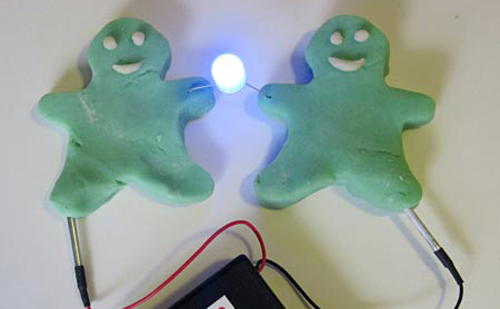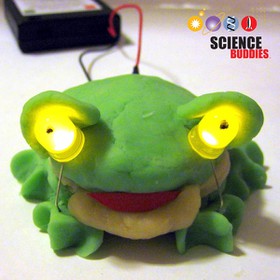Abstract
Do you like playing with play dough; or modeling clay? Wouldn't it be cool if you could add lights, sound, or even motion to your play dough creations? In this project, you will use play dough that conducts electricity, which will allow you to connect lights to your sculptures!This project is the first in a three-part series on play dough circuits, which can all be done with the same materials. We recommend doing the projects in order.
Summary
Ben Finio, PhD, Science Buddies
This Project Idea is based on work done by Dr. AnnMarie Thomas at St. Thomas University.
- Play-Doh® is a registered trademark of Hasbro.
Objective
Use play dough and modeling clay to create a simple circuit that lights an LED (light-emitting diode).
Introduction
Do you like making things with play dough or modeling clay? Then this project is perfect for you! It turns out that play dough conducts electricity. Electricity powers many of the things you use every day, like the lights in your house, and the computer you are reading this on. Once you learn more about this simple electric circuit, you can add cool things like lights or buzzers to your artistic creations.
When you add electricity to playdough to make creations with light, sound, and motion you are making a circuit. What is a circuit (pronounced "ser-kit")? A circuit is like a path through which electricity flows. A circuit needs to be made out of a conductor, which is a material that electricity can flow through easily. Conductors are usually made out of metals like copper. An insulator is the opposite of a conductor; electricity cannot flow through it. Many everyday materials—like wood, plastics, and rubber—are insulators. In this project, you will make two different materials: a conductor (Play Doh) and an insulator (modeling clay).
All circuits need to get their electricity from somewhere. Many appliances in your house (like your TV, computer, and lights) get electricity from plugs in the wall, which are connected to wires that deliver electricity to your house from power plants. Many smaller, portable circuits (such as electronic toys and cell phones) are powered by batteries, which store electricity. Batteries have two ends; one is called positive and is marked with a plus sign symbol (+). The other is called negative, and the symbol for negative is a minus sign (-), but this symbol is usually not printed on batteries.
In order for electricity to flow, there needs to be a conductive path connecting the positive end of a battery to the negative end. This is called a closed circuit. Along the way, the electricity can flow through things like lights (to make them light up). Figure 1 shows a photo of a playdough circuit powering an LED (which stands for "light-emitting diode" and is a type of tiny lightbulb found in many electronic devices) with a battery pack.
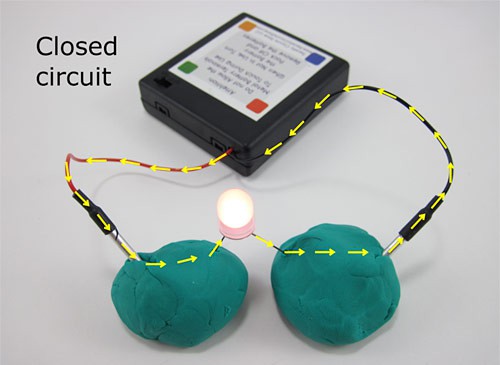
Figure 1. A closed circuit with a battery pack and an LED. The yellow arrows represent the flow of electricity. The electricity can flow through the playdough because playdough is a conductor.
If there is not a complete path through which electricity can flow, it is called an open circuit. In an open circuit, the path that electricity follows has been broken somehow. This means that there is no way for electricity to flow in a complete loop, and the LED does not light up. Figure 2 shows a picture of an open circuit.
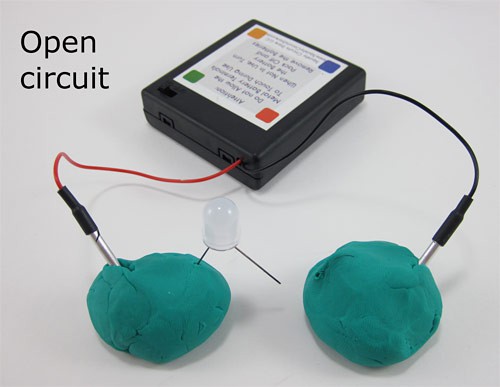
Figure 2. A picture of an open circuit. Since there is no complete path for electricity to flow, the LED does not light up.
Electricity likes to take the "easiest" possible path. If you add an easier conductive path to the circuit than the one that was already there (such as squishing the playdough into one ball instead of two), the electricity will flow through that conductive material instead of through the LED, and the LED will not light up. This is called a short circuit. Figure 3 shows a picture of a short circuit.
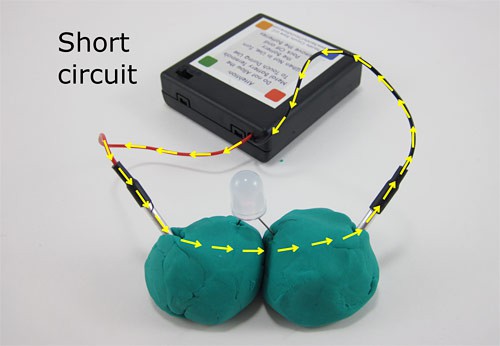
One lead of an LED is inserted into two Play-Doh balls that are connected to a battery. A short circuit occurs because the Play-Doh balls are touching directly and electricity is able to bypass the LED to complete its circuit.
Figure 3. A picture of a short circuit. The yellow arrows represent the flow of electricity. It can take the "path of least resistance" directly through the playdough, so the LED does not light up.
There are two different kinds of dough: conductive and insulating. You can use insulating dough (or modeling clay) to help prevent short circuits by putting it in between your two lumps of conductive playdough. This is shown in Figure 4.
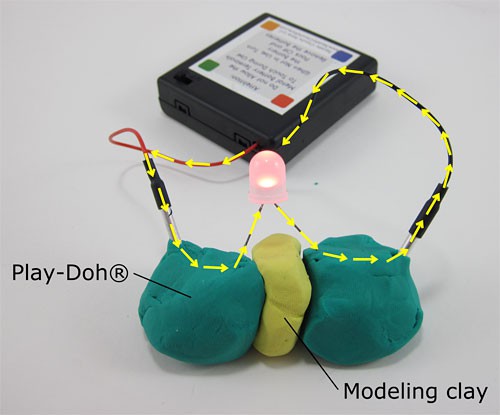
Figure 4. Insulating dough or modeling clay (yellow) can be used to help prevent short circuits by keeping clumps of conductive dough (green) from touching each other. This ensures that the electricity has to flow through the LED.
Now that you know all about playdough circuits, you are ready to start building your own! You can also read even more about electricity in the Science Buddies Electricity, Magnetism, & Electromagnetism Tutorial. Once you have finished this project, you may be inspired to try even cooler things with your electric playdough with these science projects:
- Electric Play Dough Project 2: Rig Your Creations With Lots of Lights!: You will learn to build slightly more complicated circuits that allow you to hook up multiple lights.
- Electric Play Dough Project 3: Light Up Your Sculptures!: You will use your knowledge from the first two projects to build a light-up three-dimensional sculpture.
Terms and Concepts
- Electricity
- Circuit
- Conductor
- Insulator
- Battery
- Positive
- Negative
- Closed circuit
- Open circuit
- Short circuit
Questions
- What are some examples of objects that are powered by electricity?
- What are some examples of conductors and insulators?
- Which ingredients determine whether homemade play dough is conductive or insulating?
- What is the difference between closed, open, and short circuits?
- What artistic play dough creations do you think you can make that involve lights?
Bibliography
If you want to learn more about circuits, here is an additional resource.
- The Physics Classroom. (n.d.). Requirements of a Circuit. Retrieved February 8, 2013.
Materials and Equipment 
Recommended Project Supplies
- Electric Play Dough Kit, available from our partner
Home Science Tools®.
You will need these items from the kit:
- 4xAA battery holder
- Piezoelectric buzzer
- Jumbo LEDs (25 total — 5 each in red, green, white, yellow, and blue)
- White insulating dough (3.5 oz)
- Red, blue, and green conductive dough (3.5 oz each)
- You will also need to gather these items, not included in the kit:
- AA batteries
Optional: in addition to the dough included in the kit, you can make your own conductive and insulating dough (for example, if you want other colors). See Electric Play Dough Recipes for materials and directions for making your own dough. You can also use store-bought Play-Doh® (replaces conductive dough) and modeling clay (replaces insulating dough).
Experimental Procedure

- Optional: if you are making your own homemade conductive and insulating dough in addition to using the dough in the kit, follow the instructions on Electric Play Dough Recipes.
- Insert the four AA batteries into the battery pack that came with your kit. Make sure the "+" signs on the batteries line up with the "+" signs inside the battery pack. Ask an adult if you need help making sure they are in the correct way.
- Make two lumps of Play-Doh (or homemade conductive dough) and one lump of modeling clay (or homemade insulating dough). Stick them together, with the modeling clay in the middle; make sure the two lumps of Play-Doh are not touching each other.
- Stick each metal rod from the battery pack (there should be one attached to a black wire, and one attached to a red wire) into its own lump of Play-Doh.
- Pick an LED from your kit. The two pieces of metal sticking off the LED are called "leads" (pronounced "leeds"). Insert one lead into each lump of Play-Doh. Important: Electricity can only flow through LEDs in one direction. The LED has one lead that is slightly longer than the other one; this is the positive lead, and it should be inserted into the lump of Play-Doh with the red wire. The shorter lead should be inserted into the lump of Play-Doh with the black wire.
- Use the built-in switch to turn on your battery pack. Your LED should light up! If it does not, do not worry; you probably just plugged your LED in backwards. Flip your LED around and try again (if it still does not light up, open your battery pack and make sure you inserted each battery facing the correct direction, paying attention to the "+" symbols). If you are still having trouble, read the FAQ section for help.
- Congratulations! You have made your first play dough circuit. It should look similar to the one in Figure 5.
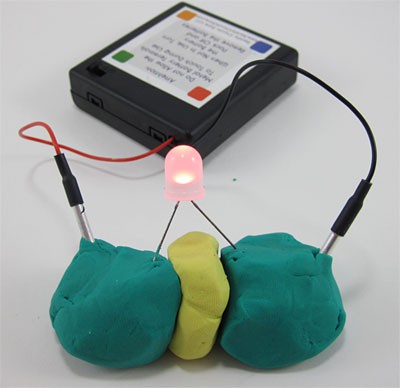
Figure 5. Your first play dough circuit should look like this.
- Now it is time to get creative! The shape of the Play-Doh lumps does not matter when connecting the LEDs, as long as there is a closed circuit for electricity to flow. Figure 6 shows two Play-Doh "people" holding hands with an LED; can you come up with your own fun designs for your own circuits?
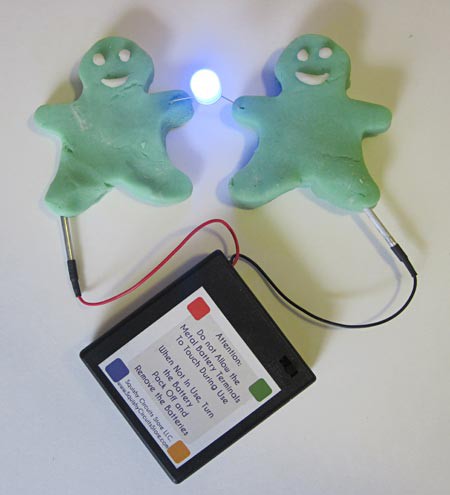
Figure 6. The shape of the Play-Doh pieces does not matter when connecting LEDs; as long as there is a closed circuit for electricity to flow (and no short circuit), the LED will still light up.
- Return the dough to its plastic containers so it does not dry out. Store homemade dough in airtight plastic bags or containers. The FAQ section has more information about how long homemade dough will last in storage.
Troubleshooting
For troubleshooting tips, please read our FAQ: Electric Play Dough Project 1: Make Your Play Dough Light Up & Buzz!.
Ask an Expert
Global Goals
The United Nations Sustainable Development Goals (UNSDGs) are a blueprint to achieve a better and more sustainable future for all.
Variations
- This project is the first in a three-part series on circuits, which can all be done with the same materials. The next two projects are
- Electric Play Dough Project 2: Rig Your Creations With Lots of Lights!: You will learn to build slightly more complicated circuits that allow you to hook up multiple lights.
- Electric Play Dough Project 3: Light Up Your Sculptures!: You will use your knowledge from the first two science projects to build a light-up three-dimensional sculpture.
- Curious about the chemistry behind this project? Research what ingredient or ingredients make the homemade doughs conductive or insulating, then try changing the recipes to see what it does to the conductive and insulating properties of the dough. For instance, how much salt do you need for the conductive dough to conduct electricity?
Frequently Asked Questions (FAQ)
This guide contains answers to some frequently asked questions for the "Squishy Circuits" project idea series:
If you are making a new batch of dough, the best way to prevent these problems is to follow the directions carefully and measure the appropriate amount of each ingredient. Some steps require you to slowly add small amounts of water until the desired consistency is formed, instead of adding the entire amount all at once.
- Make sure you properly inserted the batteries into the battery pack. Each battery is marked with a "+" symbol on one end. Make sure these symbols line up with the "+" symbols on the inside of the battery pack.
- Make sure you turn the switch on your battery pack to the "on" position when you are testing your circuit.
- Make sure your conductive dough is tightly secured around the metal leads for your battery pack. If you wiggle them around a lot and they come loose, then they will not be in good contact, and it will be difficult for electricity to flow.
- If you have a multimeter, you can use it to measure the voltage from your battery pack. Four AA batteries should provide about 6 volts (V). If the voltage is lower than 6 V, your batteries might be dead. Consult the Science Buddies Multimeter Tutorial if you need help using a multimeter.
- Remember that LEDs have a polarity, meaning they only work in one direction. The longer LED lead should be connected toward the positive side of your circuit, which is the side with the red wire protruding from the battery pack. If one LED in your circuit is not lighting up, but others are, you probably just have that LED plugged in backwards. Try reversing its direction and see if it lights up.
- Make sure your conductive dough is tightly packed around the metal leads for your battery pack. If you wiggle them around a lot and they come loose, then they will not be in good contact, and it will be difficult for electricity to flow.
- Make sure you do not have a short circuit. For more information about short circuits (including pictures and diagrams), refer to the Introduction of the first Squishy Circuits project.
- If your circuit has two or more LEDs, make sure they are wired in parallel and not in series. Wiring multiple LEDs in series will quickly cause them to become very dim. For more information about the difference between series and parallel circuits (including pictures and diagrams), refer to the Introduction of the second Squishy Circuits project.
- Make sure you are not using very long pieces of conductive play dough to connect your battery terminals to your LEDs. The conductive play dough has a fairly high resistance, which causes the voltage to drop as electricity travels through it. If you use very long pieces of conductive dough, the voltage might drop so much that the LEDs will not light up. To learn more about voltage and resistance, check out the Science Buddies Electronics Primer Introduction.
- Never connect your LEDs directly to the battery pack leads without using conductive dough in between. Connecting LEDs directly to the battery pack will cause them to burn out; too much current will flow, permanently destroying the LED. If you have LEDs that do not light up at all despite trying all the steps above, you might have accidentally burned them out at some point.
- In general, follow the same steps as in FAQ 3. For a big circuit, it is possible to have a short circuit in only part of the circuit; some LEDs might light up, while others stay dark. You might have also accidentally wired some LEDs in series, and some in parallel. Remember to always avoid short circuits, check the direction your LEDs are plugged in, and make sure your LEDs are wired in parallel.
- You can test individual parts of your circuit, one at a time. You can do this by breaking them away from the rest of your circuit and connecting them to the battery pack separately, or by sticking the battery pack leads into different parts of your circuit. This will let you identify problem areas in your circuit.
- Remember that it is possible to burn out LEDs by connecting them directly to the battery pack. If nothing else works, try swapping in a new LED.
- Both types of homemade dough (conductive and insulating) should be stored in air-tight plastic containers or plastic bags. You can put it in the refrigerator to make it last even longer.
- The conductive play dough contains salt, so will last for several weeks or months if kept in an air-tight container. Eventually, you may still see spots of mold or bacteria growing on it.
- Insulating play dough contains sugar, which bacteria and other microorganisms thrive on. You may start to see mold or bacteria growing on it after several days or a week, but it will last longer if refrigerated.
- If your play dough develops spots of visible mold or bacteria, you should throw it away and make a new batch.
- Make sure you use short, thick lumps of Play-Doh to connect the buzzer to your battery pack. The buzzer requires much more electricity to operate than the LEDs. Long, thin strips of Play-Doh have a higher electrical resistance, making it difficult for enough electricity to flow through them.
- The buzzers have polarity, just like the LEDs. Their red wires need to be connected to the battery pack's red wire, and their black wires connected to the battery pack's black wire.
Careers
If you like this project, you might enjoy exploring these related careers:
Contact Us
Our kits are developed in partnership with Home Science Tools®. If you have purchased a kit for this project, Home Science Tools® is pleased to answer any questions not addressed by the FAQ above.In your email, please follow these instructions:
- Include your Home Science Tools® order number.
- Please describe how you need help as thoroughly as possible:
Examples
Good Question I'm trying to do Experimental Procedure step #5, "Scrape the insulation from the wire. . ." How do I know when I've scraped enough?
Good Question I'm at Experimental Procedure step #7, "Move the magnet back and forth . . ." and the LED is not lighting up.
Bad Question I don't understand the instructions. Help!
Good Question I am purchasing my materials. Can I substitute a 1N34 diode for the 1N25 diode called for in the material list?
Bad Question Can I use a different part?
Contact Support
Related Links
- Science Fair Project Guide
- Other Ideas Like This
- Electricity & Electronics Project Ideas
- Technology of Art Project Ideas
- My Favorites
- Squishy Circuits Project Page


